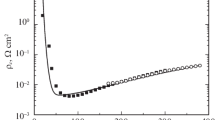Abstract
The incorporation of hydrogen into standard p-type Czochralski (Cz) silicon (≥1 Ωcm) by a 110 MHz plasma treatment at 260°C leads to the formation of an n-type region due to hydrogen enhanced thermal donor (TD) formation in hydrogenated regions of the wafer, if a subsequent annealing in air is applied at 450°C. Spreading resistance probe (SRP) and light beam induced current (LBIC) measurements were used for the experimental analysis. The p-n junction depth, i. e. the counter doping by TDs, depends on the initial doping level of the p-type substrate, and therefore on the post-hydrogenation annealing time. The penetration of the n-type region into the wafer bulk is driven by a rapid hydrogen diffusion. The essential process for a TD generation is the creation of metastable hydrogen molecular species around 260°C and their decay at 450°C.
Similar content being viewed by others
References
I.R. Job, D. Borchert, Y.A. Bumay, W.R. Fahmer, G. Grabosch, I.A. Khorunzhii, A.G. Ulyashin, MRS Symp. Proc. Series 469, 101 (1997).
A.G. Ulyashin, Y.A. Bumay, R. Job, G. Grabosch, D. Borchert, W.R. Fahrner, A.Y. Diduk, Solid State Phenomena 57–58, 189 (1997).
A.G. Ulyashin, Y.A. Bumay, R. Job, W.R. Fahmer, Appl. Phys. (A) (1998), in press.
A.R. Brown, M. Claybourn, R. Murray, P.S. Nandhra, R.C. Newman, J.H. Tucker, Semicond. Sci. Technol. 3, 591 (1988).
R. Murray, A.R. Brown, R.C. Newman, Mater. Sci. Eng. B. 4, 299 (1990).
H.J. Stein, S.K. Hahn, Appl. Phys. Lett., 56, 63 (1990).
H.J. Stein, S. Hahn, J. Electrochem. Soc. 142, 1242 (1995).
H.J. Stein, S.K. Hahn, J. Appl. Phys. 75, 3477 (1994).
F. Shimura, Oxygen in Silicon, Academic Press, New York (1994).
S.K. Estreicher, Mat. Sci. Eng. R 14, 319 (1995).
R. Murray, Physica B 170, 115 (1991).
S.J. Pearton, J.W. Corbett, M. Stavola, Hydrogen in Crystalline Semiconductors, Springer- Verlag, Berlin, Heidelberg, New York (1992).
S.M. Myers, M.I. Baskes, H.K. Birnbaum, J.W. Corbett, G.G. DeLeo, S.K. Estreicher, E.E. Haller, P. Jena, N.M. Johnson, R. Kirchheim, S.J. Pearton, M.J. Stavola, Rev. Mod. Phys. 64, 559 (1992).
A. Van Wieringen, N. Warmholtz, Physica 22, 849 (1956).
J.I. Pankove, N.M. Johnson, Hydrogen in Semiconductors, Academic Press, New York (1991).
D. Mathiot, Phys. Rev. B 40, 5867 (1989).
Author information
Authors and Affiliations
Rights and permissions
About this article
Cite this article
Job, R., Fahrner, W.R., Kazuchits, N.M. et al. A Two-Step Low-Temperature Process for a P−N Junction Formation Due to Hydrogen Enhanced Thermal Donor Formation in P-Type Czochralski Silicon. MRS Online Proceedings Library 513, 337–342 (1998). https://doi.org/10.1557/PROC-513-337
Published:
Issue Date:
DOI: https://doi.org/10.1557/PROC-513-337




